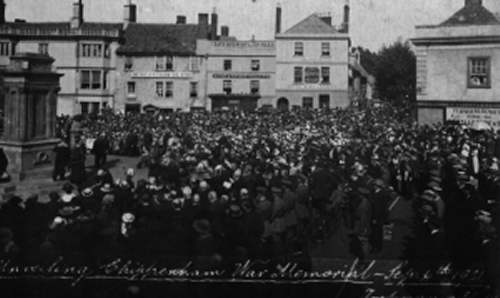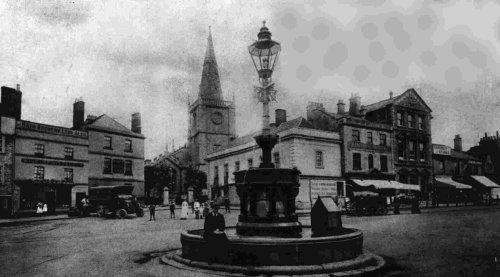Unveiling the Chippenham Town War Memorial
Speech by Field Marshall Lord Methuen
Sunday (4th Sept 1921) saw the consummation of efforts in connection
with an undertaking and a debt of honour which the Town has had in hand for
over 2 years, namely, the unveiling of the town memorial to the 160 of itís
former citizens who went forth during the war in defence of their country and
did not return. In proportion to it's population, Chippenham lost heavily in
the death toll of the war and it claimed, in common with other places, men of
all classes including one member of the Corporation and in two instances in
the town 3 in the same family were taken. From the first there was a common
desire to honour the memory of the fallen by perpetuating it in substantial
form and the Corporation, who took the matter up during the mayoralty of Coun
Hyatt, having by subscription, received sufficient to justify proceeding on
the practical stage, invited designs for a public monument.
The design accepted takes the form of a cenotaph 18 feet in height and
is situated in the Market Place facing the London Road. It stands upon the
site of the old drinking fountain erected in the 70's to commemorate the
installation of the town's water works. This fountain in recent years had
fallen into decay, and the idea of the architect was to retain the useful
proportion of the same and substitute the remainder with a substantial and
dignified monument. The result being is one of the best memorials in the West
of England. One half of the drinking trough for cattle has been retained, and
the public drinking fountain refixed at the rear of the memorial whilst
suitable portions of the other half, being of granite have been incorporated
in the design. The Cenotaph as seen from the London Road is approached by 4
steps and is flanked on both sides by piers and balustrades. The Cenotaph
itself is of masonry with renaissance columns at each angle supporting an
entablature and casque. The names of the fallen, numbering some 160 are
inscribed in a recessed panel between the front columns and will form a
lasting tribute to their fame. A niche is formed at the back there in is a
sprinkling fountain, the water rising through a pitcher overflowing into a
granite basin, then into a larger basin and finally into the cattle drinking
fountain, while at the same time, water discharges at s other points connected
direct to the town's water mains. The whole of the new masonry is of stone
from the Hornton quarries, Oxfordshire. The durability of the stone being
proved by the fact that there are memorials existing today in a good state of
preservation which were erected many centuries ago. Mr G Parker-Pearson of
Grittleton, is the architect responsible for the design of the memorial, which
has been carried out in the same efficient and artistic manner as the other
memorials that he has done. The design was one chosen by the Council from
others submitted in competition and there is no doubt that Mr Parker-Pearson's
particular treatment and use of the original fountain gained him the honour of
his design being accepted and all alike are loud in their praise of his work.
The memorial was built by Messers JF Booth and Sons of Banbury, Oxfordshire.
On the day of the unveiling, the weather was good. A large number of
people turned out to witness the ceremony. Prominence in the crowd was given
to ex-servicemen; two of their number were invited to unveil the memorial. 175
ex-servicemen under the command of Lt Bishop and Sgt Banks marched into the
square, preceded by the Salvation Army Band. Capt Booth of the building
contractors and Mr Parker-Pearson were introduced to Lord Methuen.
 At
3pm the ceremony commenced with the crowd singing the hymn 'O God, our help in
ages past'. There followed a reading of the 90th Psalm by Archdeacon Talbot of
Swindon. Prayers were said by Rev WH Gorham. Then the memorial was unveiled.
The memorial was covered by a large Union Jack, which was removed by George
Wood MM, son of Mr Joseph Wood, a late Company Sgt Maj of the Wiltshire Regt,
and Reginald Neate (late AB Royal Navy, Jutland.)
At
3pm the ceremony commenced with the crowd singing the hymn 'O God, our help in
ages past'. There followed a reading of the 90th Psalm by Archdeacon Talbot of
Swindon. Prayers were said by Rev WH Gorham. Then the memorial was unveiled.
The memorial was covered by a large Union Jack, which was removed by George
Wood MM, son of Mr Joseph Wood, a late Company Sgt Maj of the Wiltshire Regt,
and Reginald Neate (late AB Royal Navy, Jutland.)
The Mayor said that they "had unveiled the Cenotaph to the memory
of their Country men who went forth, endured hardship, faced danger and
finally passed out of sight of men in the path of sacrifice, through the gate
of death". The care of the memorial devolved upon the corporation of that
borough for all time and "on whose behalf he accepted that responsibility
and trust."
Pte HA Drummer, late Wiltshire Regiment, who had lost a leg, laid a
wreath in the form of a cross on behalf of all the ex-servicemen. There then
followed a 2 minutes silence, which was broken by Buglers Harris and Drewitt
sounding Reveille.
 The
war memorial would be in the market place, a prominent position, as everyone
travelling
along the London Road would see it. The memorial would use the existing disused
fountain. The front would have the names inscribed and the reverse would be a
small fountain and drinking trough. The memorial was designed by Mr
Parker-Pearson of Grittleton and would cost about £785.
The
war memorial would be in the market place, a prominent position, as everyone
travelling
along the London Road would see it. The memorial would use the existing disused
fountain. The front would have the names inscribed and the reverse would be a
small fountain and drinking trough. The memorial was designed by Mr
Parker-Pearson of Grittleton and would cost about £785. At
3pm the ceremony commenced with the crowd singing the hymn 'O God, our help in
ages past'. There followed a reading of the 90th Psalm by Archdeacon Talbot of
Swindon. Prayers were said by Rev WH Gorham. Then the memorial was unveiled.
The memorial was covered by a large Union Jack, which was removed by George
Wood MM, son of Mr Joseph Wood, a late Company Sgt Maj of the Wiltshire Regt,
and Reginald Neate (late AB Royal Navy, Jutland.)
At
3pm the ceremony commenced with the crowd singing the hymn 'O God, our help in
ages past'. There followed a reading of the 90th Psalm by Archdeacon Talbot of
Swindon. Prayers were said by Rev WH Gorham. Then the memorial was unveiled.
The memorial was covered by a large Union Jack, which was removed by George
Wood MM, son of Mr Joseph Wood, a late Company Sgt Maj of the Wiltshire Regt,
and Reginald Neate (late AB Royal Navy, Jutland.)